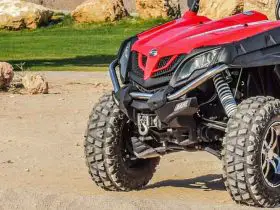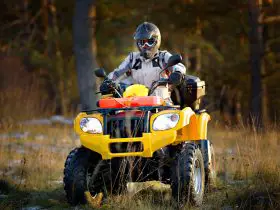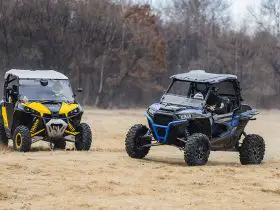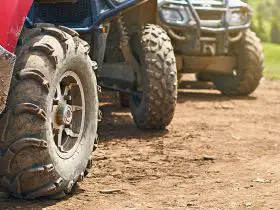The Kawasaki Teryx and the Honda Pioneer are two of the most popular UTV models around. The Teryx has a larger engine, a better warranty, and is cheaper. The Pioneer can tow heavier loads, has more seating, and has a better transmission.
So how do they compare?
In 2020, the North American ATV and UTV market reached a value of $5.69 billion. UTVs have a number of uses, and the features and capabilities of different models vary significantly.
If you’re interested in buying a UTV, it is important to make the right choice based on what you need it for. Each of these UTVs is available in multiple models. For the purposes of this guide, we will be looking at the Kawasaki Teryx base model vs. the Honda Pioneer 1000 base model.
This is a comparison of the Kawasaki Teryx vs. Honda Pioneer, including a rundown of how they compare across multiple areas. To see which is the better option for you, keep reading.
Table of Contents
Power
The engines are somewhat different between these two UTVs.
Both are four-stroke, liquid-cooled, twin-cylinder engines, but of different sizes. The Kawasaki Teryx UTV has an engine displacement of 783cc, whereas the Honda Pioneer UTV has a larger displacement of 999cc.
This gives the Honda a clear edge when it comes to engine power.
The Teryx engine is placed between the front seats. This can sometimes cause excessive heat and noise, so Kawasaki has added sound-absorbing material under the engine cover to counter this.
Despite this, and the Honda’s larger engine, the Pioneer is still the quieter of the two machines, both while idling and at speed.
Transmission
The Teryx features an automatic continuously variable transmission (CVT) with a centrifugal clutch (H, L, N, R). The clutching does a very good job of keeping the engine in just the right spot of the torque curve.
The Honda Pioneer has a dual-clutch transmission (DCT) with six forward gears and Reverse. You can switch between auto and manual with paddle shifters. Even when in auto, the paddle shifters can be used to quickly change gear if needed.
The Honda also has four drive modes: 2WD, 4WD, Turf, and Differential lock. On top of this, the paddle shifters have three different shift modes: standard, sport, and manual.
The Teryx transmission performs very well, but if you’re looking for a bit more control, the Pioneer is more suitable here.
Handling
Both of these UTVs have independent double wishbone suspension on the front and rear wheels. The Teryx allowed for 8 inches (20.32 cm) of travel at the front and 8.3 inches (21.08 cm) at the rear. The Pioneer has somewhat more with 10.6 inches (26.92 cm) at the front and 10 inches (25.4 cm) at the rear.
The wheelbase of the Teryx is 85.8 inches (218 cm) compared to 80.2 inches (204 cm) for the Pioneer, giving the Teryx an edge when it comes to overall stability.
The Teryx does lose out when it comes to tight turns, with a turning radius of 16.7 feet (509 cm). The Pioneer can perform tighter turns with a turning radius of 13.8 feet (421 cm)
Both also have electric power steering, so turning is smooth on both vehicles.
Ultimately both UTVs handle well; the Teryx provides a smoother, more stable ride, but the Pioneer is better at handling those tight turns.
Wheels/Tires
The Teryx comes standard with Maxxis tires; Maxxis 26 x 9-12 at the front, and Maxxis 26 x 11-12 at the rear.
The Pioneer also has Maxxis tires; 27 x 9-12 at the front and 27 x 11-12 at the rear.
They have the same tire width and wheel diameter for both, but the Pioneer tires are just 1 inch taller. This helps with the ground clearance, which is 11.2 inches (28.45 cm) on the Teryx and 12.7 (32.26 cm) inches on the Pioneer.
1.5 inches isn’t a huge difference, but when driving across rough terrain, it is certainly an advantage.
Both UTVs have dual hydraulic disc brakes up front, which perform very well. However, they differ at the rear. The Pioneer still has impressive dual hydraulic disc breaks at the rear, but the Teryx instead has sealed, oil-bathed, multi-disc brakes.
These are similar to what a tractor would have and are generally durable enough to last for the entire lifetime of the UTV. The sacrifice, however, is that they are simply not able to stop the UTV as well.
Overall the wheels and tires of the Pioneer are a step above those of the Teryx.
Cargo
Both the Teryx and the Pioneer have two seats, with large dedicated cargo space in the rear.
The cargo bed capacity of the Teryx is 600 lb (272 kg). For California models, this is the same for the Pioneer. This is plenty of storage for anything you need to carry in your UTV.
In other states, however, the Pioneer has a bed capacity of 1000 lbs (454 kg).
When it comes to towing capacity, the Teryx can tow loads of up to 1300 lbs (590 kg), while the Pioneer can tow a significantly larger load of 2000 lbs (907 kg). These are both quite impressive amounts, but if you need to be towing a lot of heavy loads, there are other UTVs with much higher towing capacities.
It is worth noting that the Pioneer also features a fuel reserve. It is only 1.7 gallons (7.7 L), so far from a full tank, but if you run out of fuel and don’t have any nearby, this could come in very handy.
The fuel tanks of both ATVs are the same size at 7.9 gallons (35.9 L), so the extra reserve on the Pioneer is a nice touch.
This makes the Pioneer the clear leader of the two, especially for models outside of California.
Seating
Neither of these UTVs has rear seats, instead opting for a larger cargo area. The front seats are somewhat different between the two.
The Teryx seating is more what you would expect from a UTV—two sports seats that are very comfortable, with side bolster to keep the driver and passenger stable on tough trails.
The Pioneer has a much lees conventional bench seat. This means it is lacking in overall comfort, and with no bolster to help you stay in place, you can end up sliding around when hitting twists and turns.
The tradeoff is that the bench is built for three people, which many could see as a bonus. This is less common than the standard two seats, but there are a number of other three-seater UTVs on the market.
If you think you may want to carry an extra passenger, the bench seat of the Pioneer is worth consideration here. Wherever that is not a factor, the Teryx seats are a clear step above for comfort and functionality.
Size and Weight
The Teryx has the following overall dimensions: 118.1 x 60 x 75.8 inches (300 x 152.4 x 192.5 cm). The pioneer measures 116.8 x 63 x 76 inches (296.7 x 160 x 193 cm). This makes the Teryx slightly longer, with the Pioneer being wider and taller.
These differences are very small, so they won’t be a factor for most people, but they might be worth keeping in mind if the size is a factor (for storage reasons, for example).
The curb weight of the Teryx is 1,570 lbs (712.14 kg), and the Pioneer has a curb weight of 1,538 lbs (697.6 kg). For both vehicles, this includes all standard equipment, fluids, and a full gas tank.
The Pioneer is slightly lighter, but again, this is a very small difference. Under most circumstances, it will not be a huge factor, and both can be transported in the back of a full-size truck.
Warranty
Warranties can vary from model to model. Kawasaki provides their “Kawasaki Strong 3-Year Limited Warranty” for the Teryx, which is the longest limited warranty they offer for UTVs.
Honda only provides a one-year limited warranty for the Pioneer.
Both companies offer optional extended cover. Kawasaki’s Protection Plus cover only offers one level of protection and can be purchased for an additional 12, 24, or 36 months. This means a total of 6 years cover is possible.
Honda’s “HondaCare Protection Plan” has multiple levels of cover and can provide an additional 12, 24, 36, or 48 months of cover, making a total of 5 years of cover possible.
If you are not one to opt for additional cover, the Teryx is the clear winner here. For anyone who does like to opt for extra protection, it’s a bit less clear.
Honda’s cover is a lot more flexible but can only bring the total to 5 years, while the Teryx can get 6. The preference here will likely change from person to person.
Price
The Teryx has a starting price of $13,499 MSRP, while the Pioneer has a higher starting price of $15,899 MSRP.
Kawasaki will also add on a destination charge of $720 and a freight and materials surcharge of $250, bringing the total cost to $14,469 MSRP.
Honda’s additional destination charge of $895 brings the Pioneer’s price up to $16,764 MSRP.
It is worth bearing in mind that optional extras or customizations will change the price, so a better comparison can be made based on your own preferences.
As a flat rate for these two models, the Teryx is somewhat cheaper.
Kawasaki Teryx vs. Honda Pioneer: Which Model Is Best?
Unfortunately, it is never quite as simple as saying one is better than the other. Comparing two UTVs is a subjective matter, and it all comes down to personal preferences.
If you are trying to decide for yourself the best option for you when looking at the Kawasaki Teryx vs. Honda Pioneer, it comes down to a question of what your needs are.
Will you need to use it for towing heavy loads? Is handling and control the most important factor? How important is the price?
Things like that will determine your ideal choice. If you want to think about some other options, you should take a look at our article about the best UTV brands of 2021 for some more ideas.









